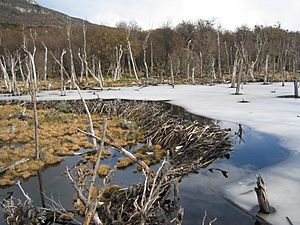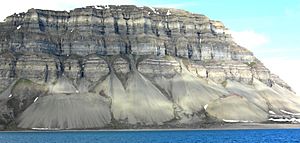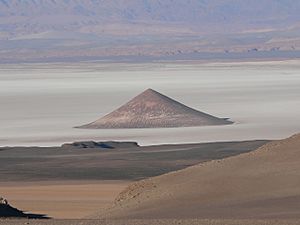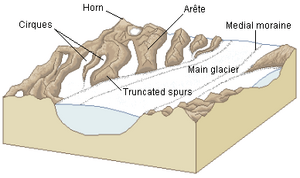Geomorphology facts for kids
Geomorphology is the scientific study of Earth's landforms. It looks at how mountains, valleys, rivers, and coastlines are made. Geomorphologists are scientists who study why landscapes look the way they do. They want to understand how landforms have changed over time. They also try to predict how they might change in the future.
These scientists use different methods to study landforms. They observe them in nature, do experiments, and use computer models. Geomorphology is connected to many other sciences. These include geography, geology, and archaeology.
Contents
How Landforms Change: Processes

Landforms are constantly changing because of different natural processes. These processes can be grouped into three main steps:
- Breaking down: Rocks and soil break apart through weathering and erosion. This creates loose material called regolith.
- Moving: This broken-down material is then moved from one place to another. This is called sediment transport.
- Settling: Finally, the material settles down in a new location. This is known as deposition.
Many forces on Earth's surface cause these changes. These include wind, waves, groundwater, and flowing surface water. Glaciers, tectonic plate movements, and volcanism also play big roles. Other processes include freezing and thawing, salt activity, and even impacts from space.
Wind Processes

Wind processes are all about how wind shapes the Earth's surface. Wind can erode (wear away), transport (carry), and deposit (drop) materials. Wind is very powerful in places with little vegetation (plants). It works best where there is a lot of loose, fine sediment, like in deserts.
Even though water moves more material in most places, wind is very important in dry areas. It creates features like dunes.
Living Things and Landforms

Living organisms also interact with and change landforms. This is called biogeomorphology. Biology can affect many geomorphic processes. For example, tiny living things can influence chemical weathering. Animals like burrowing creatures and falling trees can change soil. Even the balance of carbon dioxide, which affects climate, can influence global erosion rates.
It's rare to find landscapes on Earth where living things don't play a role. Studying these rare places helps us understand the geomorphology of other planets, like Mars.
River Processes
Rivers and streams do more than just carry water. They also carry sediment. As water flows, it picks up sediment from the riverbed. This sediment can be carried along the bottom (bed load), floating in the water (suspended load), or dissolved in the water (dissolved load). How much sediment a river carries depends on how much sediment is available and how much water the river has.
Rivers can also carve into rock, creating new sediment. They are very important in shaping large landscapes. Rivers connect different parts of the landscape.
As rivers flow, they usually get bigger and join with other rivers. This creates a drainage system. These systems can have different patterns, like dendritic (tree-like) or radial (spreading out from a center). Some landforms created by rivers include alluvial fans (fan-shaped deposits), oxbow lakes (U-shaped lakes), and fluvial terraces (flat steps along a valley).
Glacier Processes
Glaciers are powerful shapers of landscapes, even though they are only found in certain cold regions. As ice slowly moves down a valley, it causes abrasion (grinding) and plucking (pulling away) of the rock underneath. This grinding creates very fine sediment called glacial flour. When a glacier melts and retreats, it leaves behind piles of debris called a moraine.
Glacial erosion creates U-shaped valleys. This is different from the V-shaped valleys made by rivers. Areas that were once covered by glaciers but are no longer may still change faster than areas that have never had glaciers. Processes that are influenced by past glaciation are called paraglacial processes. This is different from periglacial processes, which are directly caused by ice forming or melting.
Hillslope Processes


Soil, regolith, and rock move downhill because of gravity. This movement is called mass wasting. It can happen slowly, like creep, or very quickly, like landslides and rockfalls. Mass wasting happens on both land and under the sea. It has also been seen on other planets and moons, like Mars and Titan.
When hillslopes become very steep, they can shed huge amounts of material very fast. This makes hillslope processes very important in areas where tectonic plates are active. On Earth, living things like burrowing animals or falling trees can also affect how fast these processes happen.
Volcanic Processes
Volcanic eruptions and plutonic (underground) igneous processes greatly impact landforms. Volcanoes can create new landscapes by covering old surfaces with lava and ash. They also force rivers to find new paths. The cones built by eruptions create large new hills and mountains that can then be shaped by other processes. When molten rock cools and hardens underground, it can cause the surface to uplift or sink.
Tectonic Processes
Tectonic movements can affect landforms over millions of years or just minutes. The way tectonics shapes a landscape depends on the type of bedrock underneath. Earthquakes, for example, can submerge large areas of land in minutes, creating new wetlands.
Over hundreds to thousands of years, Isostatic rebound can cause land to rise. This happens when a mountain range erodes, and the weight is removed, allowing the land to uplift. Long-term plate movements create mountain ranges. These huge mountain chains can last for tens of millions of years. They are places where rivers and hillslopes are very active, producing a lot of sediment over long periods.
Even deeper movements in the Earth's mantle can affect topography over millions of years. For example, hot rock rising from the mantle can cause the surface to uplift.
Ocean Processes
Marine processes are those caused by waves, ocean currents, and fluids seeping through the seafloor. Mass wasting and underwater landslides are also important in marine geomorphology. Ocean basins are where much of the sediment from land ends up. So, depositional processes and the landforms they create (like sediment fans and deltas) are very important in marine geomorphology.
Images for kids
-
Lake "Veľké Hincovo pleso" in High Tatras, Slovakia. This lake fills a deep basin carved by a glacier.
-
Part of the Great Escarpment in the Drakensberg, southern Africa.
See also
 In Spanish: Geomorfología para niños
In Spanish: Geomorfología para niños









